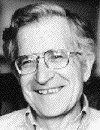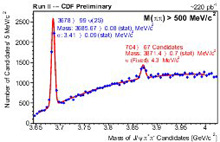 | Thursday, October 2, 2003 |
|
Thursday, October 2 2:30 pm Theoretical Physics Seminar - Curia II Speaker: D. Kosower, Centre d'Etudes de Saclay Title: Real Emission at NNLO 3:30 pm Director's Coffee Break - 2nd Flr X-Over THERE WILL BE NO ACCELERATOR PHYSICS AND TECHNOLOGY SEMINAR TODAY
Friday, October 3 |
|
Thursday, October 2 Old fashioned tomato soup Sauerbratten $4.75 Herb crusted chicken breast $3.50 Shaved ham & cheese $4.75 Monte Cristo $4.75 Turkey club salad $3.75 Sushi Eurest Dining Center Weekly Menu Chez Leon |
|
Extended Forecast |
Secon Level 3 |
| Fermilab Today is online at: http://www.fnal.gov/today/ Submit items to today@fnal.gov Fermilab Today archive Fermilab Today classifieds Subscribe/Unsubscribe to |
Noam Chomsky to Speak at Fermilab's Colloquium on October 8
|
Sloan Digital Sky Survey Meets at Fermilab 10/2-10/4 The Universe is coming to Fermilab! For five years, the Sloan
Digital Sky Survey (SDSS), a collaboration of 200 scientists from
participating institutions, has been scanning the heavens from a telescope
site in New Mexico. Their goal: a 15-terabyte map of half the northern
celestial hemisphere. The data will illuminate the birth of galaxies, the
nature of dark matter, and the evolution of the universe.
The Universe is coming to Fermilab! For five years, the Sloan
Digital Sky Survey (SDSS), a collaboration of 200 scientists from
participating institutions, has been scanning the heavens from a telescope
site in New Mexico. Their goal: a 15-terabyte map of half the northern
celestial hemisphere. The data will illuminate the birth of galaxies, the
nature of dark matter, and the evolution of the universe.
The collaboration's semi-annual meeting takes place at Fermilab
on October 2-4. About 100 members are attending to discuss recent research
using Sloan data. The keynote talk will be held on Friday at 5:30 by
Steve Majewski of The University of Virginia, an expert in the field of
galactic structures. Most of the talks will take place in One West, and all
are open to the public.
|
|
September 29 - October 1 - Recycler work during shutdown ahead of schedule - High voltage maintenance work put CDF in the dark - Pond pump line develops leak at F2 - Linac and Booster pictures: Linac water system, Booster collimator, and Linac Lambertson View the current accelerator update View the Tevatron Luminosity Charts |
|
From the Chicago Sun-Times, October 1, 2003 Illinois schools doing preliminary work for future supercollider By Sandra Guy Researchers are working to create technology they hope will pave the way for a next-generation particle accelerator to be built in northern Illinois.
The effort, led by the Illinois Consortium for Accelerator Research, is a long-term one. The U.S. Department of Energy's Office of Science could take three to 10 years to decide on a site.
|
|
CDF Observes Mystery Meson | ||
| ||
|
Mesons are bound quark-antiquark (q-qbar) pairs. The simplicity
of charmed mesons (c-cbar) could bring clarity to the unexplained
"surplus" of light mesons, observed particles that don't seem to fit the
predictions of the simple quark model. At the Lepton-Photon Symposium at
Fermilab in August, the Belle collaboration (KEK, Japan) announced the
discovery of a new meson weighing around 3872 MeV. It decays into a c-cbar
meson, called J/psi, and two pions. Named X(3872), the particle could be
just another not-yet-observed c-cbar state. But observations from Belle
instead suggest the particle might be a four-quark "molecule" (c\bar{u}-u\bar{c}),
an exotic combination allowed by theory but never so far observed.
With over 200 inverse picobarns of Run II data now on tape, CDF experimenters quickly searched for the new particle and confirmed Belle's observation, announcing their findings at last month's Quarkonium Workshop at Fermilab. The Tevatron's different vantage point offers new insights. "In Belle, we have been working hard to understand this new, narrow charmonium- like particle," said the University of Hawaii's Steve Olsen, a Belle charmonium hunter. "We were pleased to learn that CDF confirms this state with a mass value that agrees with our measurement. Detailed comparisons of the production in e+e- and p-pbar collisions may help to sort out this intriguing puzzle."
According to theorist Kuang-Ta Chao, Beijing, the large rate observed by
CDF supports the conventional
interpretation of X(3872). Whether exotic new particle or mischievous
imposter, X(3872) is an auspicious omen for future studies at the Tevatron.
| ||
|
|
Fermilab budget Lacking an Energy Appropriations Bill for FY2004, all Fermilab spending is subject to a Continuing Resolution that authorizes spending under FY2003 terms and conditions until October 31. The Continuing Resolution does not allow the initiation of new activities. read more
Pierre Auger Workshop at Fermilab 10/3-10/5
URA Scholarship Information |

